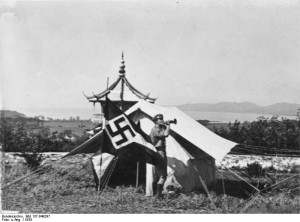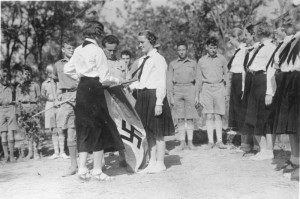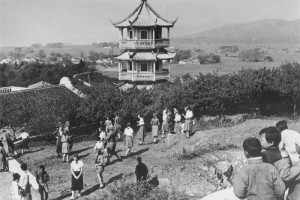Hitler Youth in China
- By Peter Harmsen
- 5 February, 2014
- No Comments
 In the inter-war years, China and especially Shanghai had a large number of German expatriates. Anecdotal evidence suggests that more than a few were initially highly skeptical of Adolf Hitler, but in the end, once he had assumed power in Germany in 1933, they were unable or perhaps even unwilling to extricate themselves entirely from the embrace of his movement. Even the children and teenagers of the German community were gradually lured into the Nazi orbit. That was what the Chinese Hitler Youth and other similar organizations were for.
In the inter-war years, China and especially Shanghai had a large number of German expatriates. Anecdotal evidence suggests that more than a few were initially highly skeptical of Adolf Hitler, but in the end, once he had assumed power in Germany in 1933, they were unable or perhaps even unwilling to extricate themselves entirely from the embrace of his movement. Even the children and teenagers of the German community were gradually lured into the Nazi orbit. That was what the Chinese Hitler Youth and other similar organizations were for.
The Shanghai Hitler Youth, for example, was established at the start of the academic year 1934, along with other Nazi youth organizations such as Bund deutscher Maedel, or the League of German Girls. Pretty much from the outset, the Shanghai Hitler Youth began serving the same purpose as the Hitler Youth at home in Germany, ie preparing young Germans for a future as soldiers for the Reich. As early as the Easter holidays of 1934, the Hitler Youth held a seven-day camp at Moganshan, a resort approximately 200 kilometers from Shanghai favored by the city’s rich, during which a wargame between a “Red” and a “Blue” side was one of the highlights.
However, it wasn’t just play. The Shanghai Hitler Youth was notorious for having stricter discipline than was the case among Hitler Youth groups in Germany proper. At camps, minor individual infringements triggered harsh collective punishments. For instance, one former member remembered what happened if someone was just ten seconds late for morning roll call: Everyone had to run back into their tents and change from shorts and T-shirts to full uniform within three minutes. If anyone failed to meet this deadline, they were ordered back into the tents to change back into shorts and T-shirts, and on and on it went. “A lot of us fainted in the hot and humid morning air,” he recalled.
Like in the German Reich, the Shanghai Hitler Youth and the other youth organizations were meant as vehicles of political indoctrination. However, it seems that many, perhaps most, of the young members had little interest in the ideological aspects of the training. For them, the chance to take part in outdoor trips and stay at camps was what counted. It was just another form of Boy Scouts, a movement that had already attracted a fair number of young Germans in Shanghai prior to 1933. A former member of the League of German Girls later recalled how she persuaded her anti-Nazi father to let her join. “The fact was that eveyone was a member, and it was pretty harmless after all. He also realized that later on.”
Despite former members’ claim that politics took a backseat, it is not entirely clear how much they ended up being impacted by the racist ideology that did take up a large part of the curriculum. For example, the photos surviving from the era suggest limited interactions with the local Chinese and other Asian nationals, which would suggest rather rigid adherence to the nonsensical theories they were exposed to about the inherent superiority of the “Nordic type”. However, the written sources tell a somewhat different story.
 In 1935, the Hitler Youth held a camp near Qingdao, a city of northeast China that had been at the center of a German colony until 1914. The city’s German consul, Enno Bracklo, gave the local Chinese governor, Shen Honglie, a tour of the camp. “The Governor repeatedly made very flattering remarks to me about the camp,” Bracklo wrote in a report to the German foreign ministry. “He is personally deeply interested in the youth movement and has used the opportunity to show the camp to local Chinese youth organizations and demonstrate the educational methods of the Hitler Youth.” Similarly, the Shanghai Hitler Youth is reported to have performed in front of visiting Japanese officers. In other words, even though Asians appear only rarely in photos of China’s Nazi youth movements, they may in fact have played a bigger role in the young Germans’ lives than normally assumed.
In 1935, the Hitler Youth held a camp near Qingdao, a city of northeast China that had been at the center of a German colony until 1914. The city’s German consul, Enno Bracklo, gave the local Chinese governor, Shen Honglie, a tour of the camp. “The Governor repeatedly made very flattering remarks to me about the camp,” Bracklo wrote in a report to the German foreign ministry. “He is personally deeply interested in the youth movement and has used the opportunity to show the camp to local Chinese youth organizations and demonstrate the educational methods of the Hitler Youth.” Similarly, the Shanghai Hitler Youth is reported to have performed in front of visiting Japanese officers. In other words, even though Asians appear only rarely in photos of China’s Nazi youth movements, they may in fact have played a bigger role in the young Germans’ lives than normally assumed.
(Source: Astrid Freyeisen, Shanghai und die Politik des Dritten Reiches, Wuerzburg: Koenigshausen und Neumann, 2000)



 Copyright © 2025
Copyright © 2025
Leave a Reply